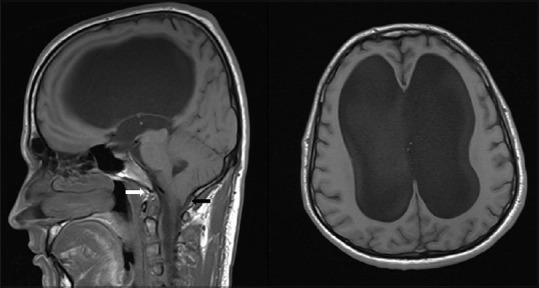Sir,
Arnold–Chiari malformation (ACM) is a disorder of embryologic development that is characterized of herniation of the cerebellar structures through the foramen magnum by four types. ACM-1 is related to hydrocephalus as a result of posterior fossa hypoplasia and causes spinal injury by obstruction to cerebrospinal fluid flow at the foramen magnum.[1]
The patient is a 36-year-old married male farmer with two children. He was admitted to the psychiatry clinic with depressive symptoms and suicidal thoughts for further examination and treatment with a diagnosis of major depressive disorder.
He mentioned that he has had difficulty in establishing successful parental and social relationships since he was in preschool. He also complained about feelings of lack of interest, tiredness, and headaches since his early twenties. His symptoms of throbbing and common headaches have increased over the years; therefore, this situation has been considered as somatic symptoms caused by depression. When nausea and vomiting were observed alongside the headaches, the patient was diagnosed with hydrocephalus after a brain magnetic resonance imaging (MRI) at the age of 34 years.
The following observations were made during his mental state examination: uninterested facial expressions, robotic movement of body parts, and reduced self-care. His speech was slow, his voice was monotone, and his response time to questions was long. He had indicated feelings of pessimism, hopelessness, guilt, anhedonia, and suicidal ideation. His affect was apathetic and incompatible with his thought content. Mini-mental test score was evaluated 30/30. A brain MRI of the patient revealed hydrocephalus and ACM-1 [Figure 1].
Figure 1.

T1-weighted magnetic resonance imaging: Width of lateral ventricle and the third ventricle were found to be severely wide (hydrocephalus). Hernia of cerebellar tonsils was found to be 8 mm long (black arrow), detected from foramen magnum (white arrow) to inferior (Arnold–Chiari malformation 1)
This case report discusses the possibility of a causal relationship between ACM-1 with hydrocephalus and the development of major depressive disorder in an apathetic patient. To the best of our knowledge, only one case has been reported of depressive disorder in association with ACM.[2] In addition, our case differs from other similar cases because our patient has severe hydrocephalus caused by his ACM-1.
Apathy is a common yet often overlooked symptom in hydrocephalus. Previous studies completed on patients with hydrocephalus showed that ventriculomegaly and apathy were associated. Moreover, apathy was found to be an important indicator of subcortical atrophy. After this patient turned 3 years, signs of introversion, slowness in movements, and having dysfunctional relationships with peers began to increase. According to his history, the diameter of his head was larger than that of his peers’ heads, which indicates that his hydrocephalus and related signs of apathy started during his childhood. According to recent studies, ACM causes depression and anxiety by pressuring on brainstem, which affects serotonergic and neuroadrenergic systems including dorsal and median raphe and locus coeruleus. In addition, apathy may be a significant obstacle for cognition and quality of life and is associated with depression.[3]
The diagnosis of ACM is often difficult because the onset of symptoms is delayed until around the patient's third decade. In the presented case, although the signs of bradykinesia and apathy had existed since childhood, the major symptoms, such as headache and dizziness, did not begin until the patient was 30 years. Consequently, this situation led to a late diagnosis and permanent psychomotor symptoms. The extended lack of treatment for his hydrocephalus caused the ventriculomegaly and a significant reduction in cortical volume. This case study shows that the cognitive reserve hypothesis is valid since the patient did not show a decline in his cognitive functions during his period of illness and the medical treatment process.[4]
Declaration of patient consent
The authors certify that they have obtained all appropriate patient consent forms. In the form the patient(s) has/have given his/her/their consent for his/her/their images and other clinical information to be reported in the journal. The patients understand that their names and initials will not be published and due efforts will be made to conceal their identity, but anonymity cannot be guaranteed.
Financial support and sponsorship
Nil.
Conflicts of interest
There are no conflicts of interest.
REFERENCES
- 1.Strahle J, Muraszko KM, Kapurch J, Bapuraj JR, Garton HJ, Maher CO, et al. Chiari malformation type I and syrinx in children undergoing magnetic resonance imaging. J Neurosurg Pediatr. 2011;8:205–13. doi: 10.3171/2011.5.PEDS1121. [DOI] [PubMed] [Google Scholar]
- 2.Caykoylu A, Deniz O, Aygül R, Aydin U, Yazici P, Alper I, et al. A case of Arnold-Chiari I malformation admitted depressive symptoms. Management. 2017;49:2. [Google Scholar]
- 3.Peterson KA, Housden CR, Killikelly C, DeVito EE, Keong NC, Savulich G, et al. Apathy, ventriculomegaly and neurocognitive improvement following shunt surgery in normal pressure hydrocephalus. Br J Neurosurg. 2016;30:38–42. doi: 10.3109/02688697.2015.1029429. [DOI] [PubMed] [Google Scholar]
- 4.Stern Y, Habeck C, Moeller J, Scarmeas N, Anderson KE, Hilton HJ, et al. Brain networks associated with cognitive reserve in healthy young and old adults. Cereb Cortex. 2005;15:394–402. doi: 10.1093/cercor/bhh142. [DOI] [PMC free article] [PubMed] [Google Scholar]


